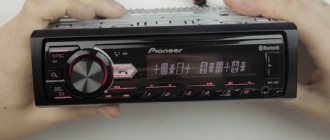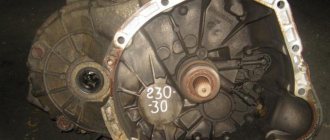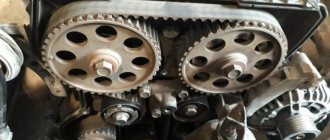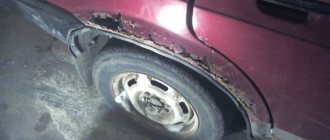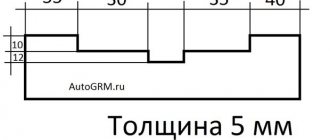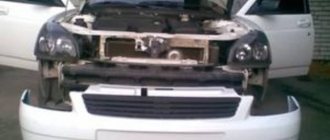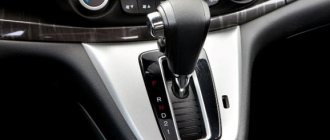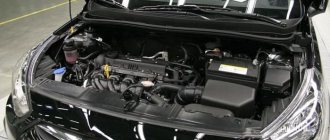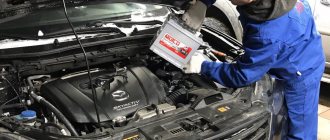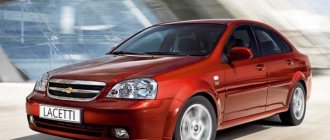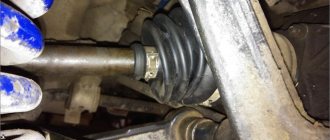Good afternoon, dear reader.
In the next article in the series “Pass the race track in half a kick” we will talk about an exercise that can safely be classified as difficult. It's called reverse parallel parking .
As for the second complex exercise, called entering the box in reverse, it was discussed in the previous article.
To be honest, parallel parking on a motorway is not much more difficult than other exercises, but most often driver candidates do not pass the traffic police exam precisely because of it. So let's look at the optimal order for completing this exercise, and also discuss common mistakes and problems:
- Exercise diagram.
- Execution order.
- Error table.
- Instructions for implementation.
- Instructions in pdf.
- Errors and problems in the exercise.
- Parallel parking in the city.
- Parallel parking on video.
Exercise diagram
The area for reversing parking is shown in the following figure:
It simulates a section of road on which 2 cars are parked below (at the side of the road or sidewalk), between which the candidate driver must carefully park his own car using parallel parking.
If during your training at a driving school you learn how to park in reverse, you will make your life much easier in the future.
Note. The distance between the standing cars in the diagram is small - only 2 lengths of our car. Therefore, it will not be possible to park in front, because... the rear of the car will protrude significantly from the “pocket”.
To get out of this situation, the authors of the exam exercises suggest using a method that is officially called “parallel parking in reverse.”
Please note that parallel parking can be useful not only when passing the traffic police exam, but also in a real traffic situation.
Well, given the constant increase in the number of personal cars and the chronic lack of parking spaces, in practice this maneuver has to be performed quite often.
Methods
There are certain ways to park in reverse, which have clear instructions and diagrams on how to do it. You can, of course, park the old fashioned way, when there were no different tricks, that is, you turn your head and drive back. This method is used by many who are not used to navigating by mirrors.
The main skill is acquired through practical application. If you recently bought a car, you can go to large sites in your free time and practice in different ways. If you immediately install parking sensors, it will be much easier, but you will not learn to park according to the schemes developed by specialists.
To learn how to properly reverse park a car, the mirrors must be adjusted so that they can see the area behind the car and on the sides. Everyone can have individual techniques. For example, some drivers lower the right mirror so that part of the rear wheel is visible. This is usually done if the rear has a high curb that could damage the bumper.
You need to develop the habit of parking correctly. Fines for illegal parking can be 1500, 3000, 5000 rubles. Also, in some cases, the car may be taken to an impound lot.
Parallel parking procedure
Let's look at what needs to be achieved as a result of the exercise:
- Drive up to the start line of the exercise and stop. Please note that the line for starting the exercise is in the figure above cone number 1.
- Cross the start line of the exercise and stop.
- Reverse between imaginary cars.
- Stay.
- Leave the exercise area.
In addition, the administrative regulations of the Ministry of Internal Affairs regulate the trajectory along which the driver must complete the exercise. Therefore, the only possible way to pass the exam is to parallel park in one go (reverse gear can only be engaged once).
Error table for exercise
The first column of the table contains descriptions of possible errors, and the second column shows the number of errors that can be made. 0 means that after the first mistake the exam is graded “FAIL”.
| Error | Possible quantity |
| 113.1. Did not start performing the test exercise within 30 seconds after receiving the command (signal) to start performing it. | 0 |
| 113.2. Knocked down marking equipment. | 2 |
| 113.3. According to the projection of the vehicle size, he drove beyond the boundaries of the test exercise areas, marked by road marking lines 1.1 white or 1.4 yellow and marking cones (marking posts), or drove his wheel onto the marking line marking the boundaries of the test exercise areas, depending on the conditions of the test. exercises. | 0 |
| 113.5. Did not cross the control line with the external dimensions of the vehicle in cases where crossing the control line is provided for by the conditions of the test exercise. | 0 |
| 113.6. Deviated from the specified trajectory of movement provided for by the conditions of the test exercise. | 0 |
| 113.7. Allowed the engine to stop. | 2 |
| 113.15. Left the exam (refused to complete the test exercise). | 0 |
When to use
In today's realities of moving around a populated area, in most cases it is very difficult to park. Because of this, parking on the side of the road is a very popular option. But even this way it is often difficult to park.
Most modern vehicles are equipped with automatic systems that provide significant assistance in such a situation. But, for example , Zhiguli cars don’t have it, so at a minimum you need to know the basics of side parking.
It must be remembered that theory in this situation is not enough. Everything that directly relates to driving a vehicle must be done automatically, and this requires experience.
Step-by-step instructions for parallel parking
Let's look at step-by-step instructions for performing the exercise:
1. Move in the direction of the start line of the exercise, stopping just in front of it.
2. Drive away and start moving forward.
The main task at this stage is to drive the right side of the car as close as possible to chip number 1. In addition, the car must completely cross the broken line at the start of the exercise.
3. Stop and engage reverse gear. Do not change the steering wheel position.
The next step is to drive a short distance in a straight line. The purpose of this point is to place the right rear wheel of the car next to cone number 1. You can check the position of the cone through the right rear view mirror.
4. Stop at chip 1, turn the steering wheel to the right until it stops.
5. Start reversing. At the same time, look in the left mirror! The car gradually turns towards the parking space. You need to move exactly until chip number 2 appears in the mirror (the correct position is shown in the figure below).
6. As soon as you see the chip in the mirror, stop.
7. Turn the steering wheel so that the car moves straight, i.e. return it to its original position.
8. Start reversing. Look in the left mirror at the broken marking line and the left rear wheel of the car. As soon as the wheel crosses the line (you only need to move a little), stop.
9. Turn the steering wheel all the way to the left.
10. Start reversing. In this case, the car ends up entering the parking pocket.
At this stage, you need to carefully look at the chips located in front of the car and navigate by them. You can ignore the rear view mirrors. As soon as the car is parallel to the edge of the imaginary roadway, stop.
11. Stop and shift into neutral.
12. Leave the parking area.
After this, reverse parking is successfully completed.
In which gear should you leave the car in the parking lot (for manual transmission)
When parking a car with a manual transmission, a driver should adhere to the following rules:
- When parking on a downhill slope, you must put the vehicle in reverse gear and immediately apply the handbrake. If the car rolls forward, reverse gear will stop the process and prevent the vehicle from moving due to the fact that the crankshaft will rotate in the opposite direction;
- When parking, even on a slight incline, the driver needs to engage first gear and raise the handbrake.
The driver needs to remember that when leaving the car, it is better to turn the wheels in the opposite direction from the roadway, especially if there is no curb in this place.
Before performing the maneuver, you need to make a parking plan in your head, and if you plan to disembark passengers, then you need to leave a space up to the curb. It is important to take your time and remain calm, even if something doesn’t work out the first time.
Errors and problems when parking in reverse between cars
Options in which you can fail “parallel parking in reverse”:
- knock down pins 3 or 4,
- stop the car on the broken marking line (if after performing the exercise the car wheel is on the broken marking line or, for example, the rear view mirror hangs over it).
knock down the poles if, before stopping in a parking zone, you try to turn the steering wheel back while driving, as some hurry-up driving instructors require. This should not be done. You can turn the steering wheel after stopping without risking failing the exam.
cross a broken marking line in two cases. The first is to try to turn the steering wheel while driving before stopping in a parking zone. The second is if you start turning the steering wheel to the left early, when the wheel has not yet crossed the broken line.
How to learn to feel the dimensions of a car
To begin to feel the dimensions of the car you need practice. There are no other magic methods. It is important not to be afraid to park, try to bring parking to the ideal, then the feeling of size will come.
We advise beginners not to be shy and to get out of the car as often as possible in order to visually control the distance to the curb or neighboring parked cars. This way you can avoid accidents and learn how to park. In addition, the side rear-view mirrors distort the distance to objects and it is difficult for a beginner to navigate solely by them. Go out and visually assess the distances, so you will learn to determine the dimensions of other cars.
If possible, practice in deserted areas, using cones or improvised objects, such as stones, as marking equipment.
In urban conditions, you can park later, when initial skills appear.
Application of parallel parking in the city
The parallel parking exercise is primarily designed to successfully park in the city.
problems may arise that are not simulated on site. The main one is that when you stop next to the selected parking space before parallel parking, the car behind you is behind you. In this case, parking cannot be performed. And since the number of cars is growing by leaps and bounds, on busy streets it is better to look for places for quick parking in front (they should be significantly larger than the length of your car).
Although you still need to know and be able to parallel park between cars. This skill will significantly expand the list of potential parking spaces.
Why are points reduced in the traffic police exam?
Today, the driving test includes several important exercises. One of them is called “Parking a vehicle and leaving a parking space.” This discipline tests skills that allow you to enter and exit a parking lot within a certain period of time without touching the marking equipment.
At racing tracks, special markings are installed, with the help of which assessment is carried out. All its cones and lines imitate the following real landmarks:
| Cone name | Point on the car body | Automobile |
| B | Left rear corner | standing in front |
| C | Left front corner | Rear |
| D | Right front corner | Rear |
This marking simulates a real situation, and therefore allows you to successfully perform such parking in the future.
When performing this exercise, errors are taken into account and the following penalty points are awarded:
- failure to complete the exercise within 2 minutes – 3 points;
- damage to fences, collision with solid lines – 3 points;
- the car did not cross the “CB” line – 3 points;
- engine stalled – 1 point.
If the examinee scores 3 penalty points, he fails.
